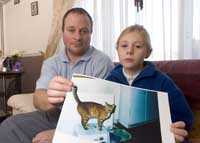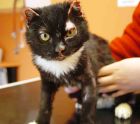Yobs Celebrating Guy Fawkes Day Kill a Twelve-Year-Old Cat Named Tigger with Fireworks; a Cat Named Sid Is Severely Burned

"Every year, it is the same story, cowardly idiots who have no sense or feelings are allowed fireworks. The sale of fireworks to the public should now be banned; only licensed firework display (sic) should be allowed."
-- Moggies
For some inexplicable reason, people all over the world are attracted to the loud bang and flash of multicolored lights associated with pyrotechnics. In the United States, they are an indispensable part of every Fourth of July celebration. For the Chinese, no lunar new year would be complete without them. The same is true for the recently concluded Guy Fawkes Day observances in England and South Africa.
As exhilarating as they are to some people, fireworks are very stressful and often deadly for both domestic animals and wildlife alike. Not only do they claim their fair share accidental and unintended victims, but there are some twisted minds in this wicked old world who get a perverted kick out of employing them in order to inflict pain and suffering upon defenseless animals.
One such sad and tragic case occurred October 31st in the London suburb of New Addington when a twelve-year-old cat named Tigger was purposefully killed by fireworks during a night of revelry in the run-up to Guy Fawkes Day on November 5th. The senseless killing has left Tigger's guardians, Ray Purkiss and his nine-year-old daughter, Stephanie, devastated. (See photo above of them holding a picture of Tigger.)
Since Tigger had burn marks all around his bottom, it is likely that fireworks were strapped to his tiny body and then ignited. As is the case with so much crime in Old Blighty nowadays, yobs are suspected.
"I suspect that it was kids. I just can't imagine that adults would do anything so cruel," Purkiss told the Croyden Guardian on November 3rd. (See "Another Cat Killed with Fireworks.") "I have lived around New Addington for thirty-five years but have never known anything quite like this to happen around here," he added.
The cat advocacy group Moggies was equally outraged. "Every year, it is the same story, cowardly idiots who have no sense or feelings are allowed fireworks. The sale of fireworks to the public should be banned; only licensed firework display (sic) should ever be allowed," a spokesperson wrote on its website.
Purkiss wholeheartedly concurs. "Fireworks are just too accessible nowadays, anyone can get hold of them -- something has to be done about it," he told the Croyden Guardian.
Indeed statistics bear out both Purkiss's and Moggies' concerns. According to the Royal SPCA, reports of injured and traumatized animals as the result of Guy Fawkes Day fireworks increased by eighty-two per cent in 2005.

A couple of days earlier on October 29th, a one-year-old gray tomcat named Sid was found severely burned and bleeding in a garden near Royston Mains Road in the Edinburgh suburb of Granton. Since he was covered in masking tape, it is patently obvious that he had been held down while rockets were taped to his body.
The cat, who was rushed to E-Vets in Edinburgh suffering from first degree burns, is now, mercifully, recuperating at Braid Veterinary Hospital in nearby Newington. (See photo on the left of him with nurse Cheryl McKenzie.) "We are very pleased that he has survived this ordeal, as the attack could have quite easily killed him," Christina Harkness of E-Vets told the BBC on October 31st. (See "Cat Scarred After Firework Attack.")
So far, the cat has responded well to treatment but it is going to take him a long time to heal. If his owner does not come forward, Sid will be transferred to the Scottish SPCA where he will continue his recuperation.
Natalie Smart of the Scottish SPCA summed up the feelings of cat lovers everywhere when she said, "The attack was brutal and unprovoked. The people responsible for this despicable act need to be caught as they may be a danger to other animals, or even to other people."
This latest atrocity comes on the heels of an especially gruesome attack last year upon a cat named Oscar (See photo below) from Hamilton, fifty-six kilometers from Edinburgh, who was not only assaulted with fireworks but also tossed onto a bonfire. Although he was fortunate enough to survive the attack, he is scarred for life.
There is an old saying that a friendly cat is a dead cat and sure enough it was Sid's and Oscar's tameness that nearly cost them all nine of their lives. "Both cats are extremely friendly and we fear that this sense of trust is what put them into danger with the thugs who carried out the attacks," Smart theorized for the Edinburgh Evening News on October 31st. (See "Police Hunt Thugs Who Taped Firework to Cat.")
Although individuals who perpetrate these diabolical acts of animal cruelty do not deserve to go on living, the death penalty would be far too humane a punishment for them. They should instead be given a strong dose of their own medicine.
In South Africa, one-hundred-twenty-one incidents involving fireworks had already been reported to the SPCA by November 3rd with many more expected over the holiday weekend.
In one particularly macabre case, a feral cat living in the Durban suburb of Clairwood was so frightened by the loud explosions that it unwittingly jumped into a barrel of tar. By the time rescuers arrived the tar had begun to set and the SPCA, rather than attempting to extricate it, elected to kill it instead.

Unfortunately, killing cats that are traumatized but not otherwise injured by fireworks is all too common in South Africa. "In some cases animals become so traumatized that they are permanently scarred and have to be put down months later," the SPCA's Jacqui Dewar told the Durban Daily News on November 3rd. (See "SPCA Officials Face Their Own Trauma.")
"It's a tough job and we have to keep our emotions on hold as we often see dead animals and badly injured ones that run into cars," Dewar added. "Often we deal with animals that have run away because of fireworks or are caged and tied up. You have to put yourself in their position and ask if you would like to be treated like that."
Although no official statistics are kept as to the number of animals killed and maimed by Fourth of July firecrackers, in 2005 thirty frightened dogs were killed by motorists when they fled into the streets of Tucson. (See Cat Defender post of July 11, 2005 entitled "Thirty Dogs Are Killed Fleeing Fireworks.") If that is any indication, the number of cats and dogs killed either directly or indirectly by fireworks must be in the tens of thousands.
Moreover, it is not only domestic animals that are harmed by fireworks but wildlife as well. Worst still, deer, rabbits, squirrels, birds, and other animals do not have anyone to either look after their well-being or to comfort them.
Photos: Croyden Guardian (Reg and Stephanie Purkiss), Rob McDougall of the Edinburgh Evening News (Sid), and Centre Press (Oscar).

<< Home